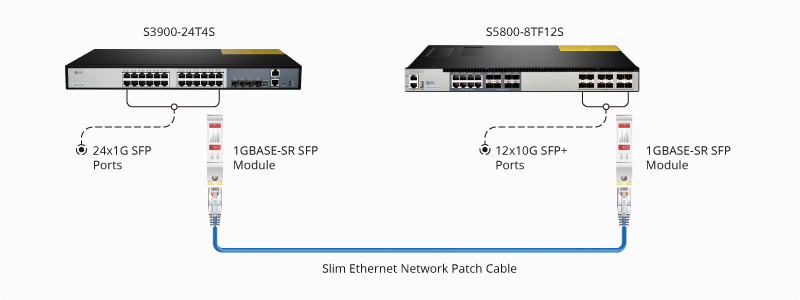

 Knowledge Base +
Knowledge Base +  2024.03.07
2024.03.07An SFP, Small form-factor pluggable, is a compact and hot-swappable transceiver used to connect a switch or other network device to copper or fiber cable. SFP replaces the formerly common gigabit interface converter (GBIC), and SFP is also called Mini-GBIC. The SFP ports on a switch and SFP modules enable the switch to connect to fiber and Ethernet cables of different types and speeds. The small formfactor pluggable, SFP, specification is based on IEEE802.3 and SFF-8472. Almost all enterprise-class switches include two or more SFP ports, enabling them to become part of a ring- or star-based network topology spread among different buildings, floors or areas, connected via fiber optic cabling.
The SFP+ standard was released in 2006 with a further update in 2011. SFP+ modules support rates up to 16 Gbps. Like the earlier SFP model, they support both fiber and copper, but copper interconnects are limited to 10 meters at 10 Gbps. The SFP+ specification supports single-mode fiber interconnects to 40 km, but some vendors support up to 80 km distances. SFP+ also supports WAN connections based on Optical Transport Network specification OTU2.
Can 10G SFP+ Optics Run at 1G SFP Port?
Will 10Gb SFP+ run at 1Gb? The answer also depends. You need to down rate the 10G SFP+ transceiver on the switch, but practically no one will be encouraged to do that. In particular, from the economic point of view, assuming that you have one 1G switch and one 10G switch and if you connect them with two 10G fiber optic transceiver modules, what you can expect to get? 1G network connectivity! Since the 10G ports can take 1G modules, and the result remains the same, why not replace 10G modules with 1G ones?

Figure 1: FS 10Gb Switch SFP+ Port Links to Gigabit Switch SFP Port
SFP vs. SFP+
SFP supports 10/1000Mbps Ethernet speed, SFP+ is an updated version that supports higher speeds up to 10Gbps and this is the primary difference between SFP and SFP+. Du to the differerent data rate, the applications and transmission distance is also different. SFP+ typically has a longer transmission distance. SFP+ specifications are based on SFF-8431. In terms of SFP vs. SFP+ compatibility, SFP+ ports often accept SFP optics but at a reduced speed of 1Gbps. However, be aware, you cannot plug an SFP+ transceiver into an SFP port because SFP+ does not support speeds less than 1Gbps. SFP+ module becomes the most popular 10 Gigabit Ethernet module in the market.
SFP and SFP+ have the same size and appearance. From the price, SFP+ is usually more expensive than SFP. The main difference between SFP and SFP+ is that the SFP+ is used in Gigabit Ethernet applications while SFP is for 100Bse or 1000Base applications. SFP doesn't support 10G transmission data rate, which means they can't be used in the same network. SFP+ transceivers use the same dimensions of pluggable transceivers in the 10Gbs Ethernet and 8.5Gbs fiber channel with SFP. SFP comply with standards of IEEE802.3 and SFF-8472 while SFP+ is based on SFF-8431.

All Things You Should Know about
Can 1G SFP optical modules run on 10G Gigabit switches?
As mentioned earlier, the standard transmission rate of the SFP+ port is 10G. Typicaly, it is connected with a 10G module. In fact, it can also be connected to a 1G module if necessary. This is attributed to its backward compatible design. This means these ports allow the insertion of 1G optical modules, enabling them to operate seamlessly. When a 1G optical module is inserted into a 10G port, the actual transmission rate is determined by the optical module itself, which effectively reduces the transmission rate of the link to 1G.
It should be emphasized that although the 10G port provides backward compatibility, it cannot expand the compatibility with optical modules whose transmission rate is lower than 1G. Specifically, 10G ports are not compatible with optical modules with a rate of 1G and below. To ensure proper functionality, it is recommended to verify compatibility with vendors, prevent potential issues, and ensure seamless operation.
Subscribe to the newsletter
for all the latest updates.
2-5# Building, Tongfuyu Industrial Zone, Aiqun Road, Shiyan Street, Baoan District, Shenzhen. China
